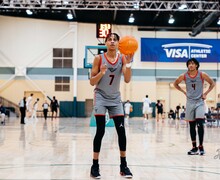Walk-on Seamus Shanley finally gets chance to start for Syracuse in senior season
David Salanitri | Staff Photographer
Seamus Shanley (74) will get a chance to start at right guard for Syracuse. He'd played in just three games as a walk on in his previous three seasons.
Joe Shanley stood giddy, waiting for Syracuse — and his son Seamus — to charge through the Carrier Dome tunnel. A DPS officer of more than eight years, Joe had worked every home football game, patrolling the student section. He’d seen it before. He’d seen his son, a walk-on right guard, come out of tunnel. He knew what it looked like.
But on Friday, for the first time in his career, he wasn’t working the game. Instead he was in section 103, in the midst of a fully-packed row of family and friends. Joe stood, talking to anyone who would listen. A beer in his hand. A faux-relaxed demeanor on his face.
“Here we go,” he said to no one in particular. “Here it comes.”
He’d seen Seamus take the field 17 times before. It never felt like this. For the first time in Seamus’ four-year career, he’d be starting.
“There’s a lot of moments I can remember personally that I look back at now and say, ‘Wow, that would have been an opportunity for you to give up,’” Joe said of his son. “But he didn’t. And it might sound cliché, but he’s been an inspiration to me.”
Seamus spent three full years waiting to get a chance that his family says he hoped to earn before this year. He came to Syracuse with just two years of football experience, walked on with the help of his father, a high school classmate of then-SU head coach Doug Marrone, and stood or sat patiently on the sidelines for 35 of his first 38 games in an Orange uniform.
It wasn’t until after Syracuse got back from Fort Drum in late August that the SU coaches started practicing Seamus with the starters. He’d impressed all camp, improving his footwork, not missing on assignments.
“In the back of my mind, you always want to shoot for the stars,” Seamus said. “You want to be that guy. You want to overachieve for yourself. But coming in, I never really thought I would get a chance like this.”
Seamus had season-ending knee surgery in his senior year of high school. He didn’t have college football offers. It was a sport he hadn’t even picked up until his sophomore year. But Joe asked Marrone to look at his tape and told Joe he could bring him on but not much else. That was the opportunity when there weren’t any others.
What followed was a steady improvement from Seamus, to the point that Marrone told Joe — after taking an NFL head coaching job — that he might have a chance to play down the road. The narrative of his career was one of a player that was team-first, a good locker room guy. But Seamus desired more.
“Sometimes, he got frustrated because he felt that he has earned a little bit more than he was given,” his sister Jessica Shanley said. “Seamus has never felt entitled to start, let alone play. But there have been moments when he comes home and he’d been a little frustrated.”
After injuring his thumb in the spring, Seamus worked out with a full cast on his hand. When Joe saw him take the field, he said that his arms were so big that they looked like legs.
Throughout camp, the Syracuse coaches kept a bulletin board with each player’s practice score. It’s a way for everyone to know how they’re doing, and how they stack up with everyone else. The score determines the depth chart. And Seamus had a higher score than now-backup Aaron Roberts, as well as few of the other starters.
Offensive lineman Omari Palmer, who is also Seamus’ roommate, said he thought the walk-on had to do even more to get the opportunity he has now. When a program is paying a scholarship player a quarter of a million dollars, Palmer said, they want that person to win the job.
“But you can’t deny production,” Palmer said. “When you go out on the field, and you consistently do what you have to do. He found a way to do it. He found a way to overcome his physical problems, which is maybe his height, his arm length, his short legs or whatever.
“He found a way to mentally push himself … which is really when you really start living. He’s living right now.”
For those close to Seamus, they’ve seen how far he’s really come. He used to be the little kid, troubled by his parents’ divorce. The one that lacked maturity and was a part of family counseling. They see how he’s now become “the golden child” as an SU senior.
They’ve seen how he went from a walk-on by convenient circumstance, to a player that could, any week, get a call saying he’s earned a scholarship.
After his family met him outside the locker room, they congratulated him and told him how well he had played. He shrugged it off. “I did OK,” he said.
For someone that’s been on an upward trajectory his entire SU career, being content isn’t something Seamus is used to.
“Sometimes people can try their best and it still isn’t good enough,” said his stepmom Jeanette Shanley. “And for him to know that he could do that and work with his team and to be able to be on that field, it’s just incredible. It’s absolutely incredible.”
Published on September 7, 2015 at 8:41 pm
Contact Sam: sblum@syr.edu | @SamBlum3





